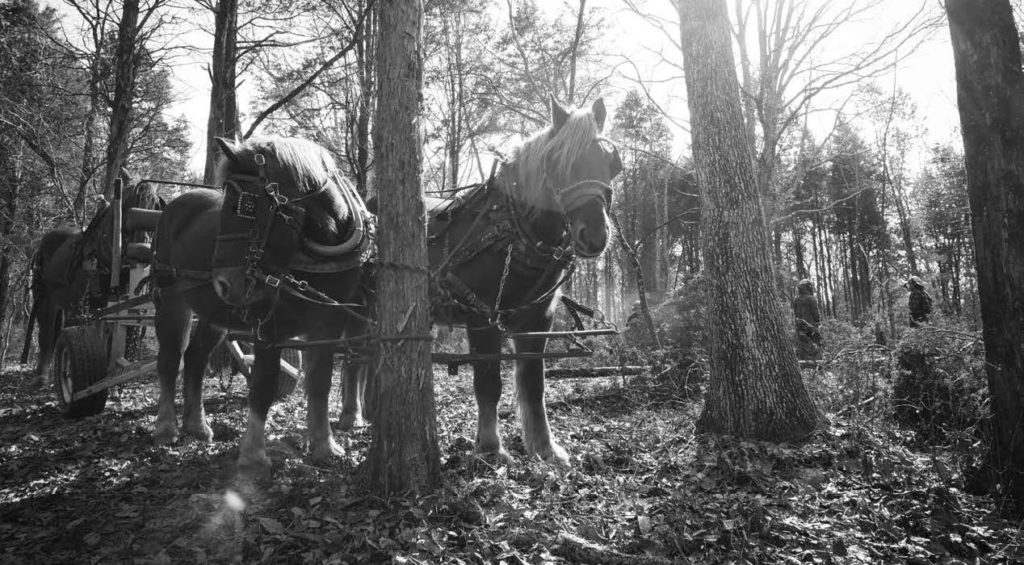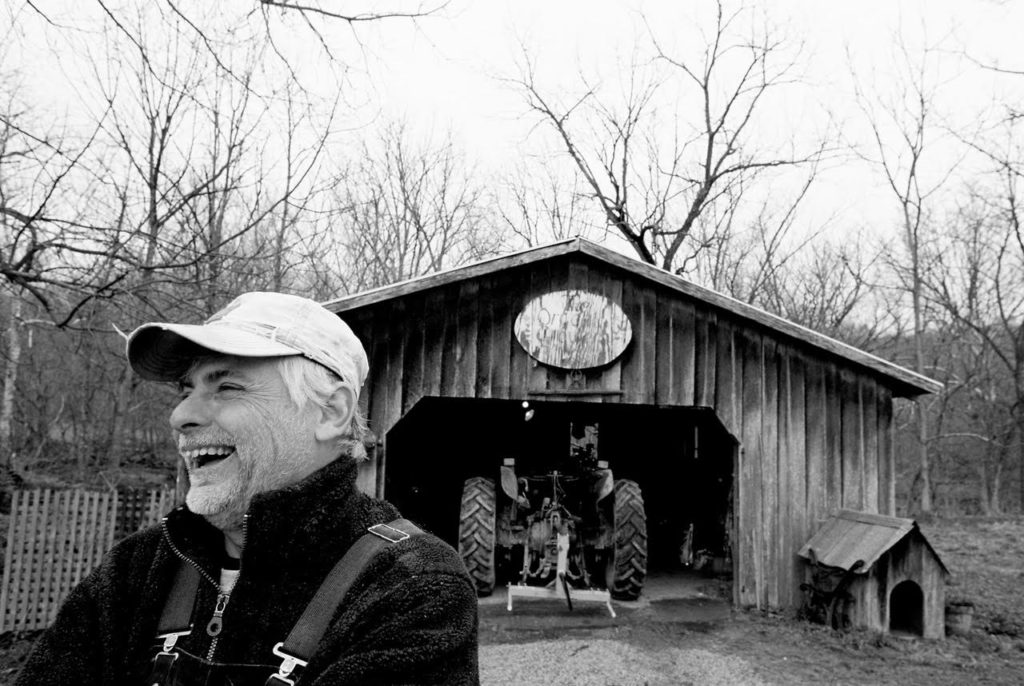This piece appeared in the 2019 edition of The Berry Center Journal. If you are interested in receiving our future publications directly to your inbox, click here to sign up for our mailing list. To read the most recent issue of the journal without signing up, click here instead.
The Wendell Berry Farming Program of Sterling College’s horse-powered forestry class, conducted in January 2019, aimed to reignite the imagination and skill needed to guarantee the long-term use and care of our forests. Thanks to a generous grant from The Endeavor Foundation, ten students took part in this immersive course at Tom and Janet Grissom’s Drennon Woods Farm in Henry County, Kentucky. Rick Thomas, Sterling College draft animal educator; Jason Rutledge, Healing Harvest Forest Foundation; and Ben Burgess, Kentucky draft horse logger and biological woodsman, led the draft-horse course.
This article by Steve Smith, a farmer who started the first Community Supported Agriculture (CSA) market model in Kentucky, is based on a presentation he gave to students during the forestry course. Steve makes the important point of how little has been done to create a local forest economy and also beautifully shows how an agrarian mind works. He makes his judgments based on his knowledge of what has happened in the past on his farm, how his years on his farm have improved the place, and what his own work has cost the place.
To make intelligent decisions about land use in a particular place takes a very high order of intelligence—intelligence that has been lost as our local economies and local cultures have been lost. How are we going to get people back to rural places who think like Steve? An agrarian culture once supplied the people. To create the local economies that supply local needs, people must be taught. That’s what the Wendell Berry Farming Program of Sterling College is all about. – TBC

A Lesson in Local Forest Economy
“We have never understood that the only appropriate human response to a diversified forests ecosystem is a diversified local forest economy. We have failed so far to imagine and put in place some sort of small-scale, locally owned logging and wood-products industries that would be the best guarantors of the long-term good use and good care of our forests.”
-Wendell Berry, Conserving Forest Communities
Our farm is on the Little Kentucky River, Bedford, Kentucky. The hills on either side are steep and heavily wooded, and most of the farming is done in the bottoms. About two-thirds of our farm is woodland, and for a long time I have thought about the possibilities for our woods. What are the alternatives to industrial logging that could provide our farm with a steady income while at the same time improving the health and integrity of the woods? The answers call for at least five things:
(1) A better understanding of forest ecology.
(2) A forest management plan that is not market driven, that is designed to improve the health of the woods and is tailored toward addressing specific problems and achieving specific goals.
(3) A local forest economy that begins by supplying local needs, adding value to our timber, getting a premium for ecologically harvested wood, and networking with wood workers, carpenters, builders, horse loggers, sawmills, and retailers to develop new markets and new market models.
(4) A market plan designed to inform and educate buyers about the benefits of ecologically harvested wood and the importance of a local forest economy to rural Kentucky.
(5) Worst first, uneven age, single-tree selection, and low-impact timber, harvesting using draft animals.
When lumber treated with chemicals was discovered to be unsafe to use as garden beds it created a demand for red cedar lumber. I had a portable band mill and had been doing some custom sawing when I started getting a lot of calls for red cedar. One was from a farm and garden store in louisville that was using the lumber to make high-end chicken coops, outdoor furniture, and garden beds. They were also supplying garden beds to local schools. Glad for the business, I began cutting cedar.

After spending several months in the woods, I was surprised to see that I had made a serious dent in the grove I was working in. There was something troubling about the way the trees were leaving so fast, too fast, I thought. At the rate I was going, how much longer could the cedar last? After seeing how the value of my lumber nearly tripled by just hitting it with a palm sander, adding brackets, and being packaged as garden bed kits, it occurred to me that I might be missing out on an opportunity, and that my lack of planning would probably cost me more than I knew. By not having an adequate forest plan I was following someone else’s plan. I was filling orders for timber, and the orders were coming faster than I could fill them. The most valuable forestry technique I had learned so far was to stop sawing trees.
Eastern red cedar is rot resistant and so are the tops and branches. left where they fall, they make good habitat for invasives like bush honey-suckle, tree of heaven, and multiflora rose, and become harder to move the longer they lay. I saw how opening the forest canopy was an invitation to invasives and how thinning the trees was therefore a better practice.
I had started by thinking that I would prefer to see these stands of cedar in pasture. However, having thought about it a good deal, I have since come to see that the problem I was ultimately wrestling with is a mistake that was made here two hundred years ago when the original forest was cut down, the hillsides were plowed, and the top soil washed away. The cedar trees have done a good job of holding the hillside in place. My expectations of these groves needed to consider that I have inherited a problem that will take thousands of years to repair, and the only elegant solution that I am likely to see in my lifetime are the groves themselves.
As an economic landscape, however, the stands of cedar are problematic for several reasons. The trees stand close together shading the ground so that not much is growing in the understory. Thinning the trees is difficult because the tops become lodged in the trees around them. In some places a few hardwoods have managed to reach the sunlight, and a few shade loving trees and shrubs like red bud and dogwood, but the stands are nearly all cedar and growing on hillsides. The steepness of these slopes make them difficult and dangerous to work on. Any disturbed soil is at risk of washing away. The work is slow. It is hard to get footing, hard to employ directional felling. Once the tree is on the ground then the real work begins. There are a multitude of branches to trim, some of them spring loaded. You are soon up to your elbows in branches with nowhere to step, trying not to pinch the saw, not to dull the chain on a rock. Your hands become coated with sticky cedar resin that is thick as molasses but not as sweet.

Given all of this, getting the trees off the hillside is work best suited for horses and mules. Having seen how horse loggers can go where tractors cannot, and with far less impact on the land, it is obvious that draft animals provide a great advantage. Assuming the stands of cedar could be managed in a way that improves the land and makes better use of it, and the problem of invasives can be solved without using herbicides, then the question is: How? what are the options? Could all the cedar be cut, and the land converted to pasture? If so, it would require periodic mowing and the land may be too steep to mow, which would limit where pasture might be established. There is also the problem of the slash (tree tops and limbs) that is slow to rot.
The question of how to manage these stands of cedar was not one I could answer while trying to fill orders. The orders for lumber had exceeded my ability to supply them long term and I was going to have to refer my buyer to another mill anyway. with the benefit of hindsight, it is easy to see that I should have had a better focused management plan and I should have shared that plan with my buyer, explaining to him why I could not supply all of his lumber, but that I could provide lumber from woods that are managed according to an ecological standard, which should be worth a premium. To receive a premium, I would supply labels, signage, and marketing materials designed to educate customers and promote better forestry.
Kentucky farmers have often considered pasture to be a better use for their stands of cedar. As part of a diversified farm economy, pasture prevented many stands of cedar from becoming subdivisions by providing an economic return to the land. but that economy is gone, and the weight of its loss has come to rest on farm communities that would greatly benefit from a local forest economy.
My experience with organic farming has helped my thinking about a local forest economy. They are in many ways similar. They both involve natural systems that are best represented as a circle, a continuous loop, an energy flow that works as long as all the parts are in place, in proportion, and in harmony with each other. It doesn’t matter where you start in the circle, it has no beginning and no end. In an organic farming system, if we start with healthy soil it leads to healthy plants, which people prefer, which pays for the better farming practices that produce healthy soil, and the loop continues. We see how each part is connected to every part. It is a natural system that is also describing a market model, which in my case was Community Supported Agriculture.

It works because the market model is appropriate to the system. What they both have in common is people, people choosing to support a model that protects and enhances the world they live in, a model based more on the Kingdom of Heaven than on Wall Street. It is a very specific kind of market model. Entrepreneurial business models are important, they provide a valuable service, they have their place in a local forest economy, but an entrepreneurial forest economy cannot compete with industrial logging.
We need a local forest economy that can compete with industrial logging by putting money into the local economy. It would be helpful if it were a part of a greater forest initiative that provided a standard of good forestry that farmers could subscribe to and receive help with forest plans and standardized marketing materials that tell the unique story of how rural Kentuckians got tired of waiting for help that was not coming and took it upon themselves to do something. It could start as a pilot project with a dozen or so farmers who understand the significance of the burley Tobacco Growers Cooperative Association model and work in that direction, all the while mindful of my friend who has the farm and garden store in Louisville, and many people like him, who would gladly support such an effort.
Steve Smith, Trimble County, Kentucky
This piece appeared in the 2019 edition of The Berry Center Journal. If you are interested in receiving our future publications directly to your inbox, click here to sign up for our mailing list. To read the most recent issue of the journal without signing up, click here instead.
